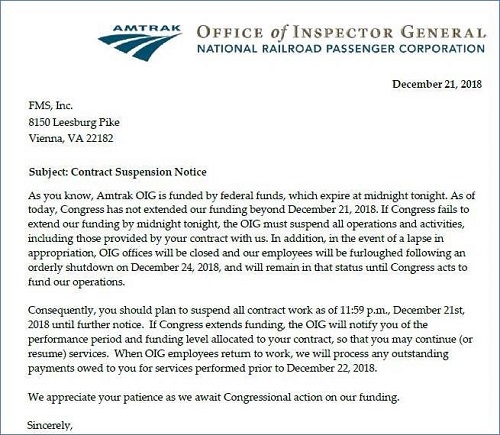Contractors Face Considerable Financial Risk
With Congress and President Trump at a budget impasse, funding for significant portions of the US Federal government ended midnight Friday, December 18, 2018. Historically, government employees are not paid on time but are retroactively paid after the new budget is implemented. The same is not true for government contractors.
Government contractors compete against each other to provide a wide range of services such as computer programming, construction, security guards, cafeterias, janitorial services, technical experts, maintenance workers, and much more. When the government shuts down, contractor staff are not needed or can’t do their work. But they are real companies and people who suffer. Long-term, it’s bad for US taxpayers.
Our Contract with Amtrak is Suspended
We have a government contract with Amtrak which was suspended by this letter:

This contract provides help for Microsoft Access database programming and is relatively small. We do not have dedicated staff for the contract, so we are not really affected as our people will work on other projects.
Unfortunately, we have colleagues who are government contractors or in businesses more dependent on the government who are significantly impacted by the shutdown. This is especially true for companies who provide staff to work at government facilities that are now closed. Most are hesitant to speak publicly about their experiences in fear their government clients would be offended, so we’d like to share our experiences and theirs.
Very Tough Situation and Decisions for Government Contractors and Their Employees
Since government contractors are unlikely to be repaid when the budget is finally resolved, government contractors with dedicated staff for those contracts need to decide whether to pay their employees for time they never expected to not charge to the government. The impact is somewhat offset by the Christmas and New Year’s holidays, and maybe they can force employees to take vacation days. But as the shutdown lasts longer, contractors will have to pay their employees from their own funds. Not paying them runs the risk that the employees leave and won’t be available once the budget is resolved. One cannot expect employees to remain loyal if they aren’t paid. Meanwhile, employees are dusting off their resumes and seeking alternative employers.
Small businesses are especially vulnerable since many contracts have small profit margins, so without significant cash and lines of credit, a cash flow problem can quickly bankrupt a company. Even generous owners who try to do the “right thing”, may not be able to if their cash is depleted. That would lead to fewer government contractors in the future and higher costs to taxpayers.
A friend of mind who owns a firm completely focused on servicing the federal government shared:
“As contractors, our employees still get paid and yet we are unable to bill. Cash is king and small companies like mine live and die by cash. This is the worst.”
Media Coverage
On December 26th, we sent a Twitter message with the letter we received from Amtrak and the sympathy we feel for government contractors and their employees.
![]() That led to our inclusion in a Washington DC News article on WUSA Channel 9 (CBS) by John Henry that evening. A video of the coverage with our Amtrak letter and insight are in this article: #ShutdownStories: Government contractors tackle life without pay during partial shutdown
That led to our inclusion in a Washington DC News article on WUSA Channel 9 (CBS) by John Henry that evening. A video of the coverage with our Amtrak letter and insight are in this article: #ShutdownStories: Government contractors tackle life without pay during partial shutdown
![]() On December 27th, I was interviewed in the Huffington Post article by Sarah Ruiz-Grossman about the challenges facing contractors entitled
On December 27th, I was interviewed in the Huffington Post article by Sarah Ruiz-Grossman about the challenges facing contractors entitled
Shutdown Leaves Government Contractors Without Work And Likely No Back Pay.
“Business owners who have [dedicated] staff are making the decision: Do we pay people or not, even though we won’t get paid by the government? Either you force people to take vacation, or you pay them, to be a good company ― but depending how long it drags on, one may not have a choice.”
![]() On December 27th, Bridget Johnson included us in her Homeland Security Today article:
On December 27th, Bridget Johnson included us in her Homeland Security Today article:
Federal Employees, Contractors Tweet Worries with #ShutdownStories
Self-Inflicted Wound that Should be Resolved Promptly
Eventually the budget will be resolved. We hope the parties come to their senses and do it sooner rather than later because innocent people who’ve dedicated their firms and lives to providing a professional service to US taxpayers are at risk and feeling real pain. That’s terrible for them now and our country long-term.







